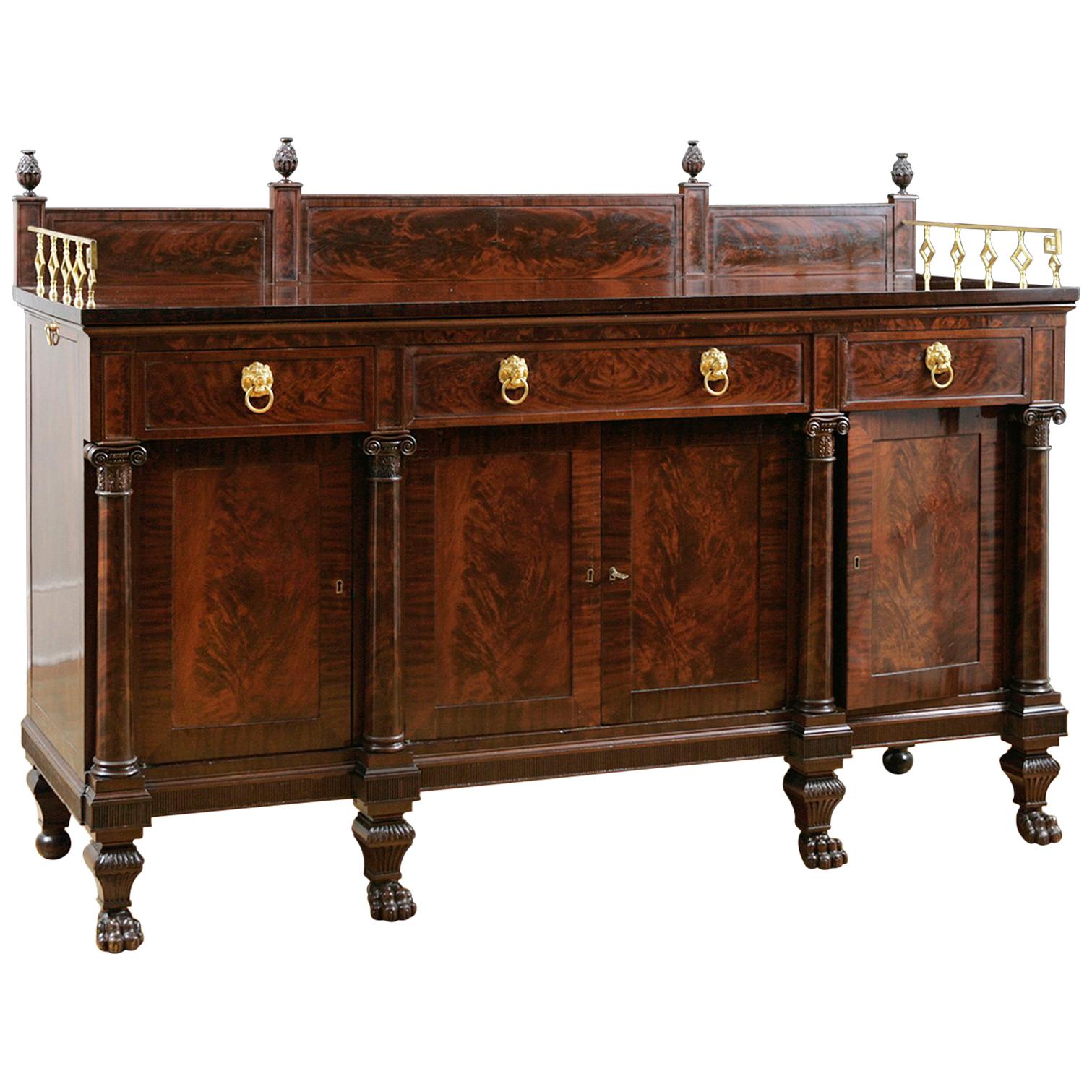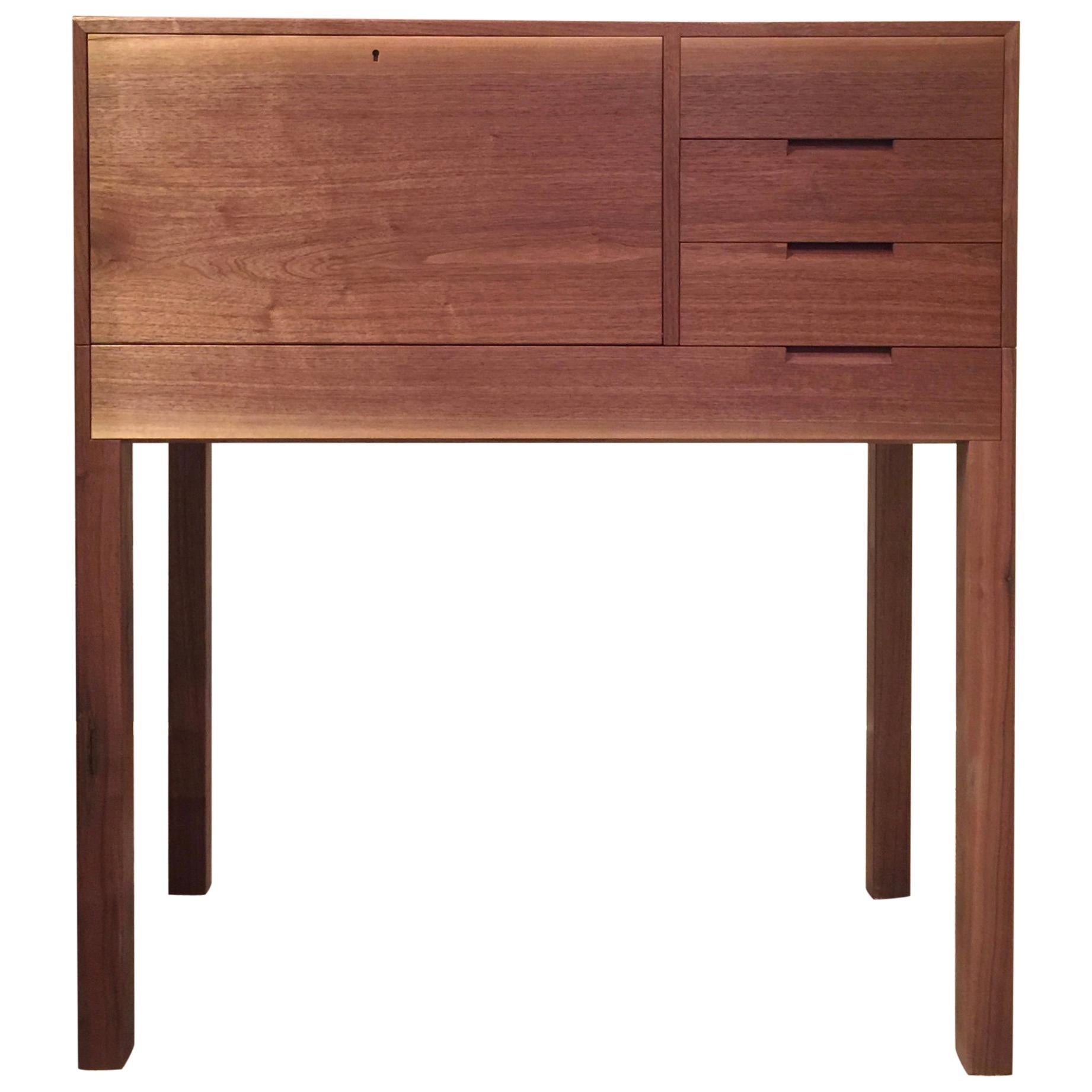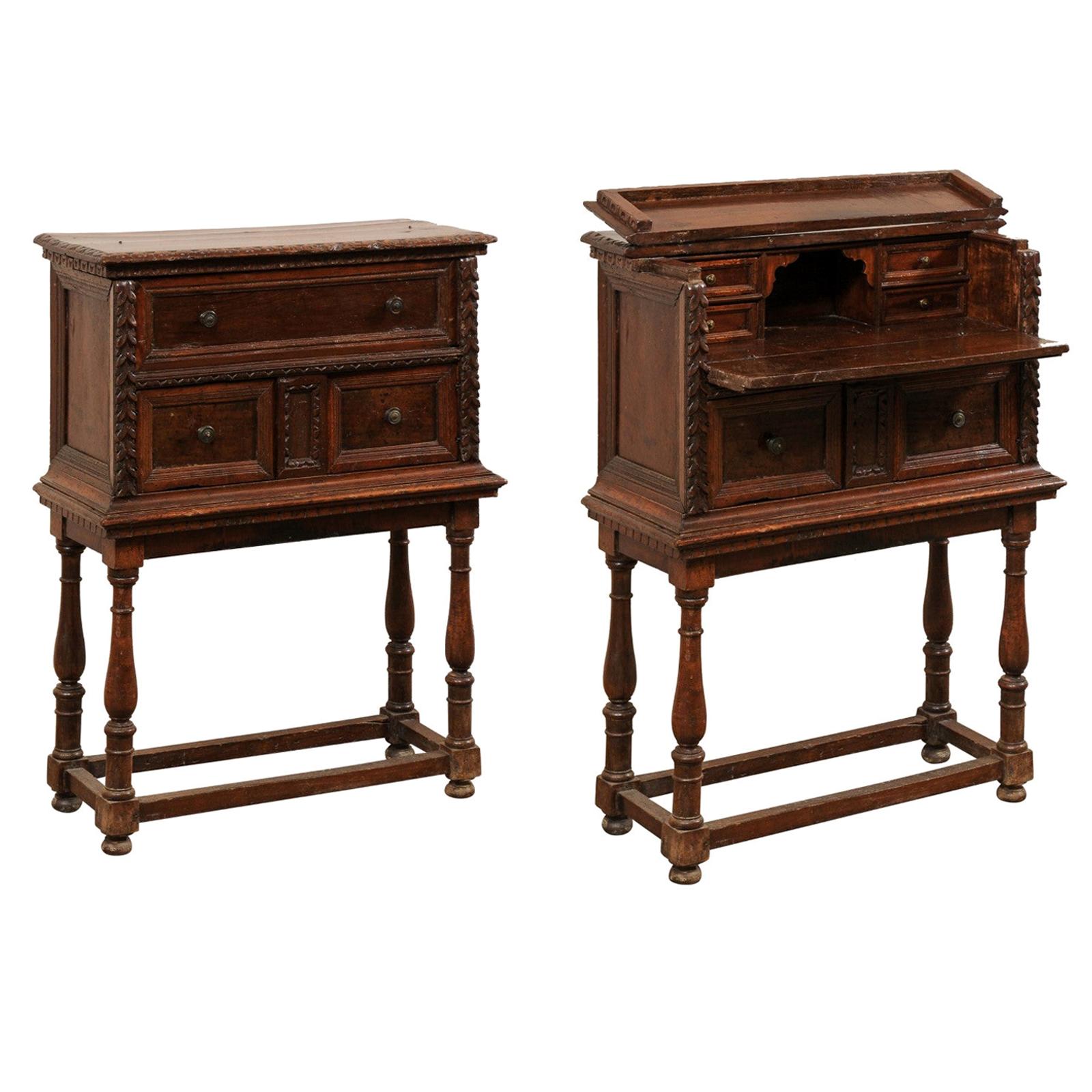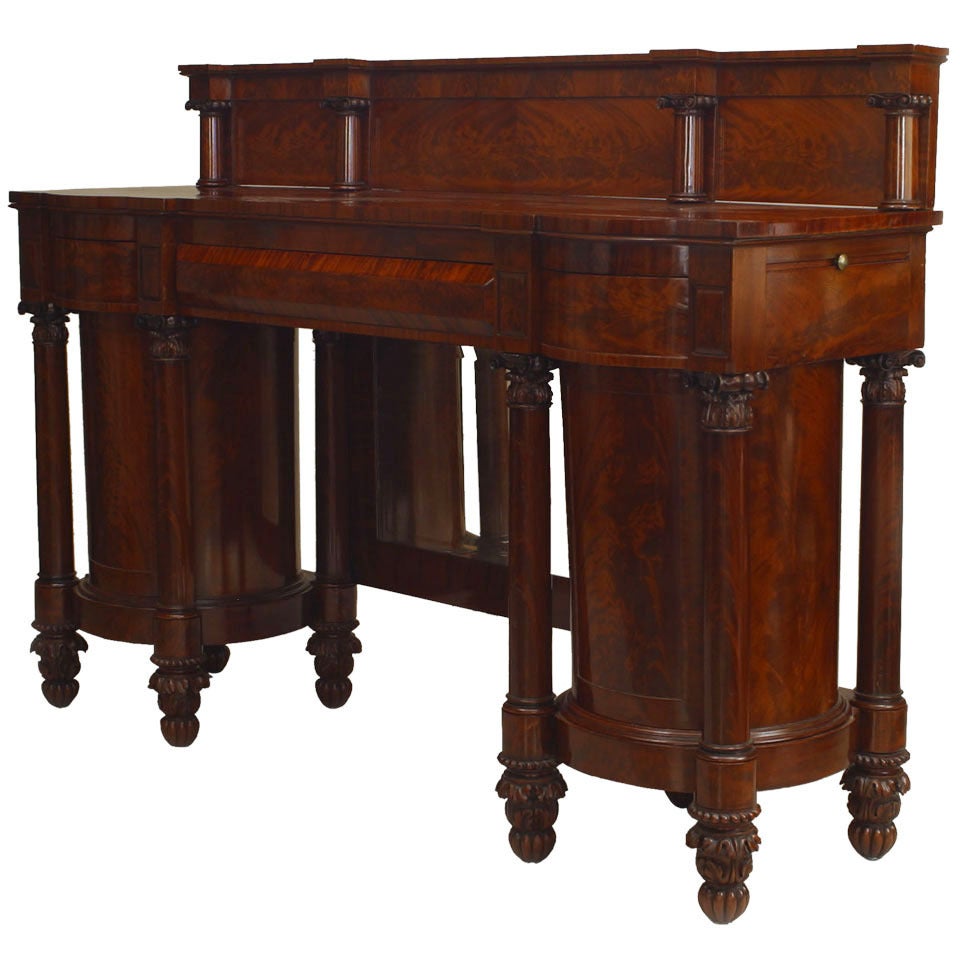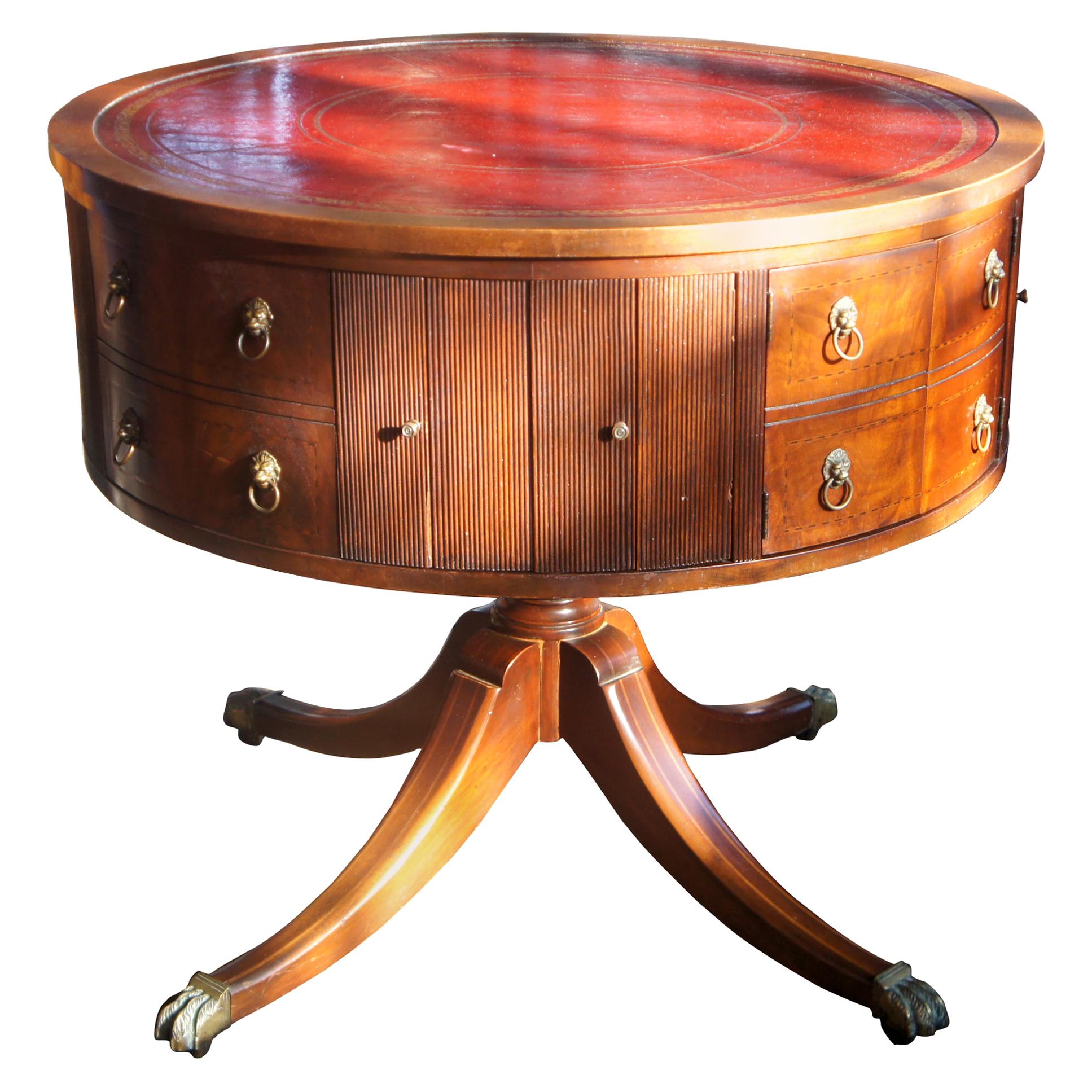Items Similar to Butler's Desk and Etagére, New York, Possibly Duncan Phyfe
Want more images or videos?
Request additional images or videos from the seller
1 of 6
Butler's Desk and Etagére, New York, Possibly Duncan Phyfe
About the Item
Butler’s Desk and Etagére, circa 1825
New York, possibly by Duncan Phyfe
Mahogany (secondary woods: mahogany, pine, poplar), with ormolu mounts, marble, and brass
54 in. high, 36 5/8 in. wide, 23 5/8 in. deep
EX. COLL.: Buffalo, New York, collection, and by descent, until 2016
Certain standard furniture forms, such as center tables, secrétaries á abattants, klismos chairs, work tables, center tables, and so forth, dominated the production of the leading American cabinetmaking shops during the Neo-Classical period, but other less usual forms were also produced, often likely on special order.
The present butler’s desk is one of those pieces, as the exact form does not seem to have previously appeared. Above the cupboard doors below is what, from the outside, appears to be a long drawer, but the front actually pulls down to form a baize-lined writing surface, with cubbyholes behind. Above the lowest of the three marble surfaces is a pair of doors revealing a storage cabinet presumably for miscellaneous household papers. Another related piece is a small sideboard that was included in the Duncan Phyfe exhibition at The Metropolitan Museum of Art, and the Museum of Fine Arts, Houston, in 2011–12 (see Peter M. Kenny, Michael K. Brown, Frances F. Bretter, and Matthew A. Thurlow, Duncan Phyfe: Master Cabinetmaker in New York, exhib. cat. [New York: The Metropolitan Museum of Art, 2011], pp. 270–71 plate 67).
Although the form of the piece is unusual in the context of American production, it does find precedent among English Regency designs, which are also echoed in a Boston étagère in a New York collection (see Stuart P. Feld, Boston in the Age of Neo-Classicism, 1810–1840, exhib. cat. [New York: Hirschl & Adler Galleries, 1999], p. 50 no. 16 illus.). But whereas the maker of the Boston piece looked to English sources for the detailing of his piece, the present piece is a blend of English Regency and French Empire design, the ormolu capitals and bases in two sizes likely being a French import.
Although the outstanding quality of this piece would suggest an attribution to the distinguished shop of Duncan Phyfe, his style became so popular among his contemporaries that it is difficult to assign the work to him without some form of documentation.
Condition: Excellent. The baize surface on the desk has probably been replaced. Cleaned and French polished.
- Attributed to:Duncan Phyfe (Cabinetmaker)
- Dimensions:Height: 54 in (137.16 cm)Width: 36.63 in (93.05 cm)Depth: 23.63 in (60.03 cm)
- Style:Neoclassical (Of the Period)
- Materials and Techniques:
- Place of Origin:
- Period:
- Date of Manufacture:circa 1825
- Condition:Replacements made. Wear consistent with age and use. CONDITION: Excellent. The baize surface on the desk has probably been replaced. Cleaned and French polished. This piece has been vetted by the Winter Antiques Show vetting committee as described in this listing.
- Seller Location:New York, NY
- Reference Number:
About the Seller
No Reviews Yet
Recognized Seller
These prestigious sellers are industry leaders and represent the highest echelon for item quality and design.
Established in 1952
1stDibs seller since 2010
Associations
Art Dealers Association of America
- ShippingRetrieving quote...Ships From: New York, NY
- Return PolicyThis item cannot be returned.
More From This SellerView All
- Pair of Oval Double Curule Benches, New York, Possibly Duncan Phyfe and SonBy Duncan PhyfeLocated in New York, NYPair of oval double Curule benches, circa 1835 New York, possibly Duncan Phyfe and Son Rosewood (secondary woods: ash and poplar), with gilt-brass castors Each, 16 3/8 in. high, 2...Category
Antique 1830s American Neoclassical Benches
MaterialsMahogany
- Center Table with Scroll Legs, Paw Feet and Marble TopsBy Thomas SeymourLocated in New York, NYCenter Table, about 1818–20 Attributed to Thomas Seymour (1771–1848), working either for James Barker or for Isaac Vose & Son, with Thomas Wightman (1759...Category
Antique 1810s American American Classical Center Tables
MaterialsMahogany, Wood
- Pair of Porcelain Urn Form Fruit Coolers with Covers and LinersBy Stône, Coquerel, and Legros d'AnisyLocated in New York, NYPair Footed Fruit Coolers, about 1810-20 Stône, Coquerel, and Legros D’Anisy, Paris (active 1808–49) Porcelain, partially transfer printed in sepia and green and gilded Each, 13 1/2 in. high x 10 in. wide x 7 1/2 in. deep Signed and inscribed (on underside of one top and one base, with printed mark): STÔNE / COQUEREL / ET / LE GROS / PARIS / PAR BREVET D’INVENTION: Manufre de Décors sur Porcelaine Faience; variously inscribed with decorators’ initial in green and brown (on underside of one top and one base): M; variously inscribed with incised mark (on underside of one liner and both bottoms): 3; inscribed (in blue script, on the inside of one liner): 615 The Parisian firm of Stône, Coquerel, and Legros d'Anisy is distinguished for the important role that it played in the introduction of transfer-printed decoration on fine china in France. Although the process had been known and used in Great Britain since the eighteenth century, it was, according to Régine de Plinval de Guillebon in her book, Porcelain of Paris 1770–1850 (New York: Walker and Company, 1972), not until 1802 that Potter, Blancheron, Constant, Neppel, Cadet de Vaux & Denuelle took out a patent in France for transfer-printing on earthenware, and it was only on February 26, 1808, that John Hurford Stône, his brother-in-law, Athanase Marie Martin Coquerel, and Francois Antoine Legros d'Anisy not only took out a patent for transfer-printing on china, but also established a Stône, Coquerel, and d'Anisy partnership for the manufacture of transfer-printed ceramics. Their address from 1808 until 1818 was at 9, rue de Cadran, Paris. Prior to this, Stône and Coquerel had been partners at a creamware factory in Creil, France, and Legros d’Anisy had worked at the Sèvres factory, where he had apparently developed the transfer-printing technique for which his own firm became well known. “The process,” notes de Guillebon, was “based upon removing from the engraving a ‘pull’ made on a specially coated filter-paper, which was pressed onto the object to be decorated; this object itself was covered with a film. Firing took...Category
Antique Early 19th Century French Neoclassical Wine Coolers
MaterialsPorcelain
- Plateau in the Restauration Taste with Grape and Leaf MotifsLocated in New York, NYFrench. Plateau in the Restauration taste with grape and leaf motifs, circa 1825. Ormolu and patinated bronze, with mirror plate and wood backing. Measures: 15 7/8 in. diameter, 3 11...Category
Antique 1820s French Neoclassical Platters and Serveware
MaterialsBronze
- Seven-Drawer Tall Chest of DrawersLocated in New York, NYBoston, Massachusetts Seven-drawer tall chest, circa 1825. Mahogany (secondary woods: mahogany, pine, and poplar) Measures: 45 5/8 in. high, 27 5/8 in. wide, 14 5/8 in. deep Inscribed (on six drawer locks): SECURE; (on seventh lock): CHUBB’S / PATENT / 57 St PAULS CHY / LONDON / CHUBB & SON / MAKERS TO / HER MAJESTY / 632284; (on one hinge): [BUR?] NE PATENT; (on master lock): 2 LEVER. Although some Boston furniture of the Neo-Classical period is elaborately decorated with ormolu mounts, brass moldings, and carved and gilded elements, other pieces are more simple and are said to reflect the “conservative” taste of many of Boston’s great families. The simplicity evident in these pieces is not an indication of a less-expensive line of furniture or a less-sophisticated patronage, but, like the so-called “Grecian Plain Style” of Duncan Phyfe’s furniture...Category
Antique 1820s American Neoclassical Commodes and Chests of Drawers
MaterialsMahogany
- Small Settee in the Neoclassical TasteLocated in New York, NYSmall Settee in the neoclassical taste Boston, Massachusetts (active 1804–17), about 1810 Mahogany (secondary woods: ash) Measures: 35 1/8 in. high, 59 3/4 in. long, 19 1/8 in. deep Although the diminutive scale of this settee places it in a unique category, the piece itself partakes of a vocabulary that is common in Boston furniture of the Late Federal period. Its sabre legs, for example, as seen straight on from the left and right ends, are closely related to the legs, as seen from the front, on a group of chairs of undisputed Boston origin, including a spectacular armchair with scrolled arms (see Stuart P. Feld, Boston in the Age of Neo-Classicism, 1810–1840, exhib. cat. [New York: Hirschl & Adler Galleries, 1999], p. 37 no. 6 illus. in color), as well as a number of side chairs, including a set made for Nathan Appleton (see Page Talbott, “Boston Empire Furniture, Part I,” The Magazine Antiques, CVII [May 1975], p. 887 fig. 12). In all, the legs are ornamented with two bold, somewhat flattened reeds set between corner beads, a pattern which is repeated here on the front and end seat rails as well. The superb quality of the piece is further demonstrated in the finely drawn profile of the arms, as well as the delicately bulbous surface of the fronts of the arms and legs. As in the best of the related chairs, the sabre legs end in delicately carved paw feet. The added refinement of the beautifully carved rosettes at both the fronts and backs of the arms suggests that the piece may have been designed to be used in the round. Stylistically harmonious with these pieces is also a group of larger sofas with frontally set sabre legs and scrolled arms (see Page Talbott, “Seating Furniture in Boston, 1810–1835,” The Magazine Antiques, CXXXIX [May 1991], p. 963 pl. 11) that represent an indigenously Boston form. Although none of the furniture in this group has been effectively attributed, they can certainly be related to various Boston card tables...Category
Antique Early 19th Century American Neoclassical Settees
MaterialsWood
You May Also Like
- American "French Sideboard" Attributable to Duncan Phyfe, New York, circa 1815By Duncan PhyfeLocated in Miami, FLAn exceptionally fine and rare "French Sideboard Table" in mahogany, attributable to the workshop of the eminent New York cabinetmaker, Duncan Phyfe, circa 1810-1818. This exquisit...Category
Antique Early 19th Century American Federal Sideboards
MaterialsBrass
- Butler's Desk or Walnut SecretaryBy Brian HolcombeLocated in Princeton, NJA contemporary take on the butler's desk. A butler's desk is a cabinet that converts into a desk, concealing its function. A desk, standing on its own looks out of place without an accompanying chair and lamp, but a cabinet that functions as a desk looks fine all by itself. This is entirely handmade, down to the desk hardware...Category
21st Century and Contemporary American Desks
MaterialsBrass
- 18th C. Italian Butler's Desk Nicely Raised on Turned Leg BaseLocated in Atlanta, GAAn Italian butler's desk from the 18th century raised on later base. This antique case piece from Italy has the appearance of being a three drawer chest at first glance. However, upo...Category
Antique 18th Century Italian Desks
MaterialsWood
- Duncan Phyfe American Empire Mahogany SideboardBy Duncan PhyfeLocated in New York, NYAmerican Empire mahogany sideboard with two pedestal cabinets and 4 carved column supports centering a lower mirror under 3 drawers ...Category
Antique Late 18th Century American Empire Sideboards
MaterialsMahogany, Mirror
- Italian Victorian Butler's Cabinet, Late 19th CenturyLocated in Los Angeles, CAVictorian butler's cabinet, Late 19th century Italian Renaissance-style, in carved walnut with gilt, ebonized, and glazed highlights with central sphere crest atop six opposing gl...Category
Antique Late 19th Century Italian Cabinets
MaterialsGlass, Wood, Walnut
- 1940s Brunswick Panatrope Drum Table Sheraton Duncan Phyfe Mahogany Music RadioBy Brunswick Co.Located in Dayton, OH1940s Brunswick Panatrope drum table Sheraton Duncan Phyfe mahogany music radio An extremely rare piece that both fits the aesthetic and musical va...Category
Vintage 1940s Sheraton Center Tables
MaterialsLeather, Mahogany
Recently Viewed
View AllMore Ways To Browse
Antique Furniture In New York
Empire Design
Cleaning And Polishing Antique Furniture
Used New Age Cabinets
New York Mahogany
Secretary New
Form And Surfaces Doors
54 Cabinet
36 Antique Cabinet
Used Duncan Furniture
Small Sideboard Antique
Antique Small Sideboard
Desk With Sideboard
36 Drawer Cabinet
Antique Butler
Antique Butlers
Small Writing Table And Chair
Duncan Antique
